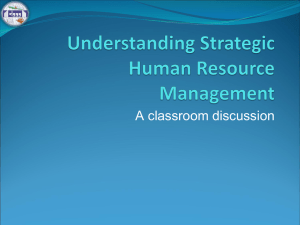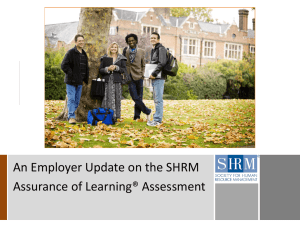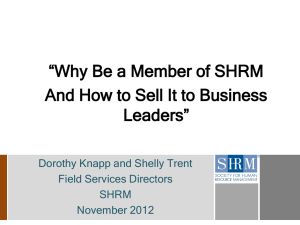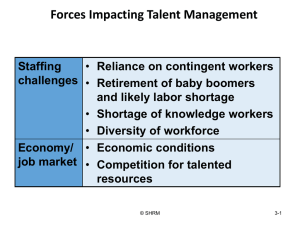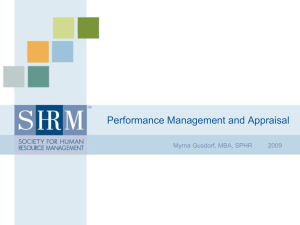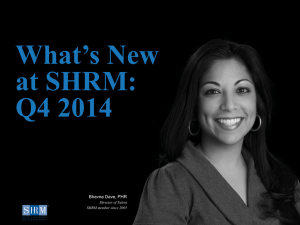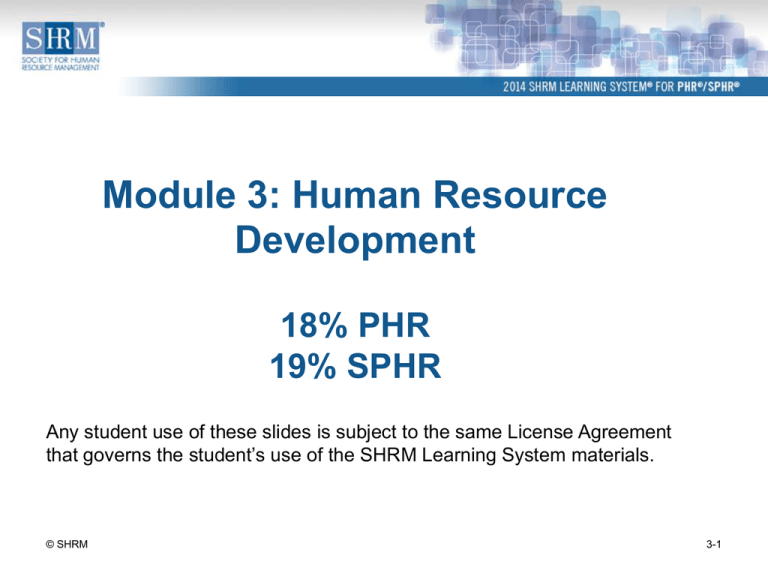
Module 3: Human Resource
Development
18% PHR
19% SPHR
Any student use of these slides is subject to the same License Agreement
that governs the student’s use of the SHRM Learning System materials.
© SHRM
3-1
HRD
• Provides employees
with the skills to
meet current and
future job demands.
• Aligns HRD activities
with organization's
goals.
Organizational
strategic goals
HRD activities
Business results
© SHRM
3-2
An organization wants to reduce its research
and development time by 50%. Which of the
following training events is MOST closely
linked to this corporate goal?
A.
B.
C.
D.
Time management training
Data collection and analysis training
Leadership training
Conflict resolution training
Answer: B
© SHRM
3-3
The Learning Organization
Organization is characterized by its capability to
adapt to changes in its environment.
Learning is accomplished by the
organizational system as a whole.
Systems thinking is practiced.
Employees network internally and
externally.
Change is embraced.
Failures become opportunities to
learn.
© SHRM
3-4
Which of the following occurs in a
learning organization?
A. The organization selects people who will receive
training.
B. Emphasis is on team learning, not individual
learning.
C. Learning is connected to organizational goals.
D. Each employee creates his or her own vision of the
organization.
Answer: C
© SHRM
3-5
Knowledge Management
Focuses on:
• Expertise sharing and
organizational learning.
• Knowledge retention
and recovery of
knowledge lost due to
employee attrition.
© SHRM
3-6
Global Impact on HRD
SPHR only
• Organizational change and knowledge
management become more complex.
• Western motivation models may not apply.
• Demand for multilingual/multicultural training
increases.
• Focus may be less on knowledge and skills
than on power of relationships, awareness,
mindsets, and personal networks.
• Talent management and retention increase in
importance.
© SHRM
3-7
Hofstede’s Value Dimensions
SPHR only
Culture affects training topics and methods.
• Power distance (extent to which less-powerful members
of organizations accept that power is distributed
unequally)
• Uncertainty avoidance (extent to which people cope
with anxiety by minimizing uncertainty)
• Individualism/collectivism (extent to which people stand
up for themselves and choose their affiliations)
• Masculinity/femininity (value placed on traditional male
or female roles in Western cultures)
• Long-term/short-term view (extent to which society
embraces long-term commitments and tradition)
© SHRM
3-8
Low- and High-Context Cultures
SPHR only
Low-Context Culture
High-Context Culture
Communication is direct,
structured, and specific.
Shared background is not
assumed.
Communication is less clear
because of common
understandings and a shared
culture.
A higher value is placed on
the words spoken than on
the nonverbal
communication.
Meanings are derived from
nonverbal communication.
Behavior and beliefs are
spelled out explicitly.
Face-saving and tact are
balanced with the need to
communicate fully and
frankly.
© SHRM
3-9
Elements for HR Success
© SHRM
3-10
Copyright Act
• Protects literary,
artistic, or other
creative expression.
• Protects the author’s
right to reproduce,
distribute, or perform
copyrighted work.
• Introduces the
concepts of public
domain and fair use.
© SHRM
• Person who creates a
work generally owns
the copyright, except
for work-made-for-hire
exceptions such as:
– Works created by
employees.
– Works specially
ordered or
commissioned.
3-11
Which of the following is a work that
has fallen into the public domain?
A. A pop song written in 1980
B. An article in an HR magazine
C. An HR textbook revised in 1997
D. A government pamphlet
Answer: D
© SHRM
3-12
Under the fair-use standard, trainers
may
A. copy a Learning System module for a friend.
B. cite and copy a paragraph from an article and
pass it out at a staff meeting.
C. copy a chapter from an HR textbook and hand
it out to a class.
D. copy any materials for a free training session.
Answer: B
© SHRM
3-13
Equal Access to Training
• Equal access to training and career development
is guaranteed by:
– Title VII of the Civil Rights Act of 1964.
– Uniform Guidelines on Employee Selection
Procedures.
– Americans with Disabilities Act (ADA).
– Age Discrimination in Employment Act (ADEA).
– Uniformed Services Employment and Reemployment
Rights Act (USERRA).
© SHRM
3-14
Organizational Culture
Shared values and perceptions that:
Give members
an
organizational
identity.
Facilitate
commitment.
Shape
behavior.
© SHRM
Promote
system
stability.
Impact an
organization’s
success or
failure.
3-15
OD Intervention Process
3.
Evaluate
the results.
1.
Diagnose
the environment.
HR roles:
• Change agent
• Evaluator
2.
Develop
an action plan.
© SHRM
3-16
OD Interventions
Interpersonal
• Work relationships
between
employees
Technological
•
•
•
•
Process analysis
Job design
Specialization
Work-flow
analysis
Structural
• Span of control
• Reporting
relationships
Examples: Team building, flexible work and
staffing, diversity programs, quality initiatives
© SHRM
3-17
Systems Theory
• Applied in organizational development
interventions.
• Essential to the quality movement and leads
to process improvement.
• Based on understanding the relationship
between three key components:
Inputs
© SHRM
Process
Outputs
3-18
Process-Flow Chart
Coordinator identifies judgment issue and develops questionnaire.
Prospective participants are identified and asked to cooperate.
Coordinator sends questionnaires to willing participants, who record their
judgments and recommendations and return the questionnaires.
Coordinator anonymously compiles summaries and reproduces participants'
responses.
Coordinator sends the compiled list of judgments to all participants.
Participants comment on ideas and propose a final judgment.
Coordinator looks
for consensus.
Coordinator accepts consensus judgment as group's choice.
© SHRM
3-19
Control Chart
Control Chart for Surface Finish
150
Upper Control Limit
Surface Finish (Microinches)
130
110
Process Center
90
70
50
Lower Control Limit
30
© SHRM
1
3
5
7
9
11
13
15
17
19
21
23
25
27
29
Measurement Number
31
33
35
37
39
41
43
45
47
49
3-20
Cause-and-Effect Diagram
Machine
People
Label error
Cosmetic
defects
Deburring
machine
Wrong part used
Wrong
packaging
Milling
machine
Assembled wrong
Assembly
Failures
Unable to
adjust
Unit leaks
Low-cost
supplier
Failed test
Tried to cut
corners
Method
© SHRM
Surface roughness
on sealing surfaces
Material
3-21
Scatter Diagram
Income
Level
Education Level
© SHRM
3-22
Histogram
150
125
100
Number of
Transactions
75
50
25
0
30
60
90
120
Time in Seconds
© SHRM
3-23
Pareto Chart
100%
100
90
90%
93%
80%
86%
80
80%
70
70%
72%
60
90%
60%
63%
50%
50
45%
40
40%
30
30%
20
20%
10
23%
22%
18%
9%
6%
8%
4%
3%
7%
10%
0
0
Unit
Wrong
Failed Assembled Label
leaks parts used test
wrong
error
Cosmetic Unable
Wrong
defects to adjust packaging Other
Number of Occurrences
© SHRM
3-24
Six Sigma
• Data-driven methodology for eliminating
defects.
• A process must not produce more than
3.4 defects per million opportunities.
• Six Sigma employees (Green Belts) and
project leaders (Black Belts) are
overseen by quality leaders (Master
Black Belts).
© SHRM
3-25
Adult Learning Principles
Adults want training that:
• Focuses on “real world” issues.
• Applies to their jobs.
• Meets their goals and expectations.
• Allows for debate and challenge of ideas.
• Encourages an exchange of ideas and
opinions.
• Allows them to be resources to each other.
• Meets a current need.
© SHRM
3-26
Which of the following is LEAST likely to
affect a participant’s readiness to learn?
A. Motivation
B. Ability
C. Tenure with the organization
D. Perceptions of the work environment
Answer: C
© SHRM
3-27
Learning Styles
Visual
Auditory
Kinesthetic
© SHRM
3-28
Retention
Retention will be increased by appealing to
all learning styles.
I m m ediat e use of lear ning
90%
80%
Pr act ic e by doing
70%
Approximate
retention rate
60%
50%
Dis cussion
40%
Dem onst r at ion
30%
20%
10%
Reading
Lect ur e
Degree of part i ci pat i on
© SHRM
3-29
Learning
Learning
Learning Curves
Time
Time
Decreasing returns
Increasing returns
© SHRM
3-30
Learning
Learning
Learning Curves
Time
Time
S-shaped curve
Plateau curve
© SHRM
3-31
Bloom’s Taxonomy
Highest level
of learning
Evaluation
Synthesis
Levels
of
Learning
Analysis
Application
Comprehension
Knowledge
Lowest level
of learning
© SHRM
3-32
Maslow’s Hierarchy of Needs
Off the Job
On the Job
SelfActualization
Education, religion, personal growth
Approval of family, friends, community
Opportunities for growth development, problem
solving, creativity
Esteem
(self and others)
Family, friends, community groups
Belonging and Love
Freedom from war, pollution
Safety and Security
Training, recognition, high status, increased
responsibilities
Work groups, clients, coworkers, supervisors
Working conditions, employment security,
pay, and benefits
Physiological Needs
(air, food, drink, shelter, sleep, sex)
© SHRM
3-33
Herzberg’s Motivation-Hygiene
Theory
Working
Conditions
Pay
Extrinsic
Hygiene
Factors
Supervision
© SHRM
Coworkers
Personal
Growth
+
Intrinsic
Motivation
Factors
Recognition
=
Motivation
Achievement
3-34
Which of the following intrinsic factors
affect an employee’s willingness to do
the job?
A. Opportunities for recognition and relationship
with coworkers
B. Opportunities for personal growth and
achievement
C. Working conditions and job security
D. Job environment and pay
Answer: B
© SHRM
3-35
McClelland’s Theory
High achievers:
• Set moderately difficult but potentially
achievable goals.
• Prefer to work on a problem rather than leave
the outcome to chance.
• Seem to be more concerned with personal
achievement than with the rewards of success.
• Seek situations in which they get concrete
feedback on how well they are doing with regard
to their work.
© SHRM
3-36
McGregor’s Theory X and Theory Y
X
(Rigid
control)
(Rigid control)
Y
Continuum
Continuum
Theory X
© SHRM
(Autonomy)
(Autonomy)
Theory Y
People inherently dislike
work and will try to avoid
it.
People do not inherently
dislike work.
People have to be coerced
and threatened with
punishment if the
organization’s goals are to
be met.
People do not like rigid
control and threats.
Most workers like
direction and will avoid
responsibility.
Under proper conditions,
people do not avoid
responsibility.
Managers operate from an
authoritative style.
Managers operate from a
participative style.
3-37
Vroom’s Expectancy Theory
• Key variable is level of effort.
• Decision to exert the effort depends
upon three factors.
Should I
exert
effort?
© SHRM
1. Expectancy
2. Instrumentality
How likely is it that I
will reach my
performance goal?
Will I receive various
outcomes if I reach my
performance goal?
3. Valence
How desirable or
undesirable are
these outcomes?
3-38
A first-line supervisor desires a management
position. However, only college graduates seem to
be promoted. The employee decides not to enroll
in college since balancing work and school would
be too hard. According to Vroom, the employee
A. does not believe that a college degree will lead to a
management job.
B. does not want a management position badly enough.
C. does not trust organizational management.
D. lacks confidence in himself.
Answer: B
© SHRM
3-39
Adams’s Equity Theory
Based on the fact that people want to be treated
fairly.
Inputs:
effort, education,
seniority
=
Outcomes:
pay, status,
benefits
Tension exists when similar inputs do not equal
similar outcomes. Employees may adjust their
behavior or quit their jobs.
© SHRM
3-40
Skinner’s Behavioral Reinforcement
Theory
Positive
Reinforcement
Negative
Reinforcement
Person
repeats
desired
behaviors to
gain a desired
reward.
Person works
to avoid an
undesirable
consequence.
© SHRM
Punishment
Response
causes
something
negative to
occur.
Extinction
Unlearning
undesired
behavior
because of no
response or
reinforcement.
3-41
Applications of Motivational Theories
Motivational theories are the basis for:
• Positive reinforcement.
• Design of work and work
environment (intrinsic).
• Goal setting.
• Formal extrinsic rewards.
• Pay-for-performance
systems.
© SHRM
3-42
The ADDIE Model
Assessment
Design
Development
Evaluation
Implementation
Systematic development process used to create
employee learning that aligns with strategic
goals.
© SHRM
3-43
Assessment
Identify
needs.
Form basis
for evaluation.
Purpose of
Assessment
Find
performance
gaps.
Identify
programs
and target
audience.
© SHRM
3-44
Needs Assessment Levels
Organizational
Task
Individual
© SHRM
Examines KSAs needed
as organizations and jobs
change.
Compares job requirements
with employee knowledge
and skills.
Focuses on individual
employees and how they
perform.
3-45
Needs Assessment Process
1. Gather data.
5. Implement.
2. Determine
training needs.
4. Calculate cost.
3. Propose solutions.
© SHRM
3-46
Which assessment method would be MOST
appropriate to assess the training needs for
a national chain of 550 retail stores?
A. Assessment centers
B. Focus groups
C. Interviews
D. Surveys
Answer: D
© SHRM
3-47
Design
Decisions are made
regarding:
• Goals and objectives.
• Target audience
(aptitude, prior
knowledge, and
attitudes).
• Selection of an
instructional designer.
© SHRM
Training objectives use
the SMART format:
S
M
A
R
T
Specific
Measurable
Attainable
Realistic
Timely
3-48
Development
Involves the creation of training materials.
Development trends include:
• Use of learning objects (LOs) or reusable
learning objects (RLOs).
– Saves development time by reusing content in a
variety of contexts in the organization.
– Object may be an animated graphic, a job aid, or a
module of a course.
• A dedicated learning management system (LMS)
to hold course content and track employee
activities.
© SHRM
3-49
Types of Training Programs
• Skill development
–
–
–
–
–
–
© SHRM
Basic or remedial
Technical
Sales
Interpersonal
Quality
New technology
• Other types
–
–
–
–
–
–
–
Executive
Personal development
Wellness
Diversity
Workplace violence
Ethics
Harassment/discrimination
prevention
3-50
Delivery Methods and Media
• Classroom training
• Self-directed study
• E-learning
− Synchronous or
asynchronous
• Blended learning
• On-the-job training
Dependent on:
• Learning objectives
• Cost limitations
• Time frame
• Equipment
• Audience
© SHRM
3-51
Implementation
• Program is delivered to the audience.
• Most visible step in the ADDIE process.
• Primary tasks are:
Utilizing pilot
programs
© SHRM
Revising
content
Scheduling
the
program
Announcing
and
implementing
the
program
3-52
Evaluation
• Measures program effectiveness.
• Builds HR credibility by showing tangible
results.
• Desired outcome is transfer of training—
applying knowledge and skills learned in
training to the job.
© SHRM
3-53
Evaluation Levels
Kirkpatrick’s Levels of Evaluation
Evaluation Comparison
Level
Reaction
Frequency of Use
Ease of Use
Value of
Information
Highest
Highest
Lowest
Lowest
Lowest
Highest
Learning
Behavior
Results
© SHRM
3-54
Levels of Evaluation: 1 and 2
SPHR only
Level 1: Reaction
Measures reaction
of participants to
the training.
Checklists
Questionnaires
Interviews
© SHRM
Level 2: Learning
Measures the learning
of facts, ideas,
concepts, theories.
Post-measures
Pre-/post-measures
Pre-/post-measures with
control group
3-55
Levels of Evaluation: 3 and 4
SPHR only
Level 3: Behavior
Measures a change in
behavior.
Level 4: Results
Measures
organizational results.
Performance tests
Critical incidents
Progress toward
organizational objectives
360-degree feedback
Performance appraisals
Simulations/observations
ROI, cost-benefit analysis
© SHRM
3-56
Talent Management
• Development and integration of HR processes
that attract, develop, engage, and retain the
knowledge, skills, and abilities that will meet
current and future needs
– Strategic approach to human capital management
– Increases workplace productivity and ability to
compete
• Should be aligned with organizational goals
and executed as an ongoing process
© SHRM
3-57
Forces Impacting Talent Management
Staffing
• Reliance on contingent workers
challenges • Retirement of baby boomers
and likely labor shortage
• Shortage of knowledge workers
• Diversity of workforce
Economy/ • Economic conditions
job market • Competition for talented
resources
© SHRM
3-58
Orientation and
Onboarding Programs
• Orientation provides initial exposure to:
– Organizational information.
– Policies, procedures, and benefits.
– Work context.
• Onboarding promotes assimilation into:
– Organizational culture and norms.
– Specific departments and functions.
– Support systems (e.g., mentoring, work/life
balance).
© SHRM
3-59
Career Development
Career management:
Organizational
focus
Career planning:
Individual focus
Career development occurs when the needs of the
organization and the individual coincide.
© SHRM
3-60
Model for Career Development
Late career
Mid career
Early career establishment
and achievement
Organizational entry
Occupational preparation
© SHRM
3-61
Career Development Programs
• Employee self-assessment
• Individual coaching/counseling
• Employee development programs
– Apprenticeship and continuing education
– Committee participation
– Job rotation, enlargement, and enrichment
© SHRM
3-62
A mid-level manager might regularly meet
with a senior executive during which
career development option?
A. Mentoring
B. Fast track
C. Job enrichment
D. Expatriation/repatriation
Answer: A
© SHRM
3-63
Dual Career Ladders
Identify meaningful career paths for people who are not
interested in traditional management roles.
Level 5
Chief Information Officer
Level 5
Senior Technical Specialist
Level 4
Director
Level 4
Technical Specialist
Level 3
Department Head
Level 3
Technical Lead
Level 2
Senior Information Systems Specialist
Level 1
Information Systems Specialist
© SHRM
3-64
Succession and Replacement
Planning
Succession
• Long-term; 12-36
months.
• Focuses on
leadership talent for
the future.
• Develops leaders
capable of filling
multiple
assignments.
Replacement
• Short-term; 0-12
months.
• Focuses on
immediate needs.
• Develops backup
staff for key
positions.
Fast-track programs speed the development of
potential leaders.
© SHRM
3-65
Employee Needs
SPHR only
• Flexible staffing
–
–
–
–
Flextime/telecommuting.
Compressed workweek.
Job sharing.
Phased retirement.
• Diversity
– Training facilitates
communication and
productivity among all
employees.
© SHRM
• Expatriation
– Sending employees
abroad and supporting
their ability to succeed.
• Repatriation
– Reintegrating
employees into their
home country.
3-66
Leadership and Management
• Leadership requires alignment to the
organization’s vision and mission.
– Leaders influence others toward the achievement of
goals, act as change agents, serve by example, and
develop other leaders.
• Management is about coping with day-to-day
operations.
– Brings order and consistency to the organization.
– Establishes systems and structures that get results.
© SHRM
3-67
Which responsibility is MOST
characteristic of a leader?
A. Evaluating recommendations from a corporate
communications survey
B. Implementing a corporate ethics program
C. Reviewing and adjusting sales forecasts
D. Establishing a vision for the organization
Answer: D
© SHRM
3-68
Behavioral Dimensions of Leadership
Consideration
(employeecentered)
• Behavior aimed at meeting the
social and emotional needs of
groups and individuals.
• Helping group members and
explaining decisions.
Initiating
structure (joboriented)
• Behavior aimed at careful
supervision of work methods
and performance levels.
• Clarifying roles and setting
goals.
© SHRM
3-69
Blake-Mouton’s Theory
Managerial Grid
A great deal
9
Country club
manager
Concern
for
People
Team
leader
Middle-of-theroad manager
Impoverished
manager
1
Very little
Authoritarian
manager
9
A great deal
Concern for Production (Task)
© SHRM
3-70
Hersey-Blanchard’s Theory
Leadership styles match the situation.
High
Selling
Participating
Share ideas and
facilitate in
Relationship decision making
Behavior
(Supportive
Behavior)
Low
Relationship/
Low Task
Delegating
Low
© SHRM
High
Relationship/
Low Task
Turn over
responsibility
for decisions
and implementation
High
Task/
High
Relationship
Explain decisions
and provide
opportunity
for clarification
Provide
specific
instructions;
closely supervise
performance
Task Behavior
(Guidance)
High Task/
Low
Relationship
Telling
High
3-71
Fiedler’s Contingency Theory
• Favorableness of the leadership environment
is determined by three factors:
– Leader-member relations: The degree of trust that
followers have in their leaders.
– Task structure: The extent to which tasks are
defined.
– Position power: The degree of power and influence
a leader has over subordinates.
• Leaders should change the factors rather than
changing their style.
© SHRM
3-72
Leadership Styles
• Transactional:
– Offers promise of
reward or threat of
discipline.
– Looks for deviation
from rules.
– Intervenes when
standards are not met.
– Abdicates
responsibility and
avoids making
decisions.
© SHRM
• Transformational:
– Provides vision and
sense of mission.
– Communicates high
expectations.
– Promotes intelligence
and problem solving.
– Gives personal
attention and
coaches.
3-73
Emotional Intelligence
• Ability to be sensitive to and understand
emotions of others and to manage own emotions
• Four branches:
–
–
–
–
Perceiving emotion
Using emotion to facilitate thought
Understanding emotion
Regulating emotion
• Positive correlation between leadership
effectiveness and emotional intelligence quotient
(EQ)
© SHRM
3-74
Performance Management System
Drives business results that accomplish the
goals of the organization.
Organizational values and goals
Performance management standards
Employee performance/behaviors
Measurement and feedback
Business results and employee growth
© SHRM
3-75
Fostering a High-Performance
Workplace
Organizations must provide:
• Executive support.
• Challenging work
environment.
• Employee
engagement
activities.
• Performance
management training.
© SHRM
• Continual feedback.
• Resources and tools.
• Consistent
management
practices.
3-76
Individual Performance Appraisals
1. Observe employee
performing the job.
5. Set goals for performance
improvement.
4. Provide reinforcing and
corrective feedback on
employee performance.
© SHRM
2. Identify and record strengths
and areas for improvement.
3. Rate employee on progress
toward previously stated
objectives.
3-77
Appraisal Methods
• Category rating methods
– Simple marking of
performance level
– Graphic scale, checklist,
forced choice
• Comparative methods
– Compare performance of
employees
– Ranking, paired
comparison, forced
distribution
© SHRM
• Narrative methods
– Written narrative
appraisals
– Essay, critical incidents,
field review
• Special methods
– Designed to overcome
appraisal difficulties
– MBO, BARS
3-78
Which appraisal method is best
exemplified by the following?
Low
1
2
3
4
5
High
Quality
A.
B.
C.
D.
BARS
Forced distribution
Graphic scale
Ranking
Answer: C
© SHRM
3-79
Errors in Performance Appraisal
Halo/horn
Contrast
Central
tendency
Recency
Errors
Leniency
Primacy
Bias
Strictness
© SHRM
3-80
Legal Performance Appraisals
• Performance appraisal methods must be:
– Valid and free of discrimination.
– Based on formal evaluation criteria.
– Based on personal knowledge of and
interaction with employees.
– Designed to prevent one manager from
overinfluencing an employee’s career.
– Based on equitable treatment of all
employees.
© SHRM
3-81
Appraisal Feedback Guidelines
•
•
•
•
Describe the behavior; don’t judge it.
Assume an attitude of helpfulness.
Empathize and listen actively.
Give specific examples.
© SHRM
3-82
Documentation Guidelines
• Document as situations happen.
• Keep notes on all employees, not just a
few.
• Use objective criteria.
• Support job-related observations with
facts, but avoid conclusions.
• Focus on deficiencies, not causes.
• Remember that others may read your
comments.
© SHRM
3-83

